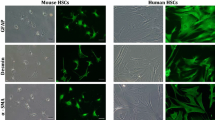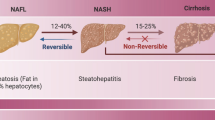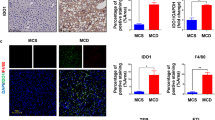Abstract
Hydroxysteroid sulfotransferase 2B1b (SULT2B1b) sulfates cholesterol and oxysterols. Hepatic oval cells (HOCs), thought to be progenitor cells, can be triggered in chemically injured livers. The present study focused on the role of SULT2B1b in HOC proliferation after liver injury. Our experiments revealed that the expression of SULT2B1b was increased dramatically in a chemical-induced liver injury model, mainly in HOCs. Upon challenge with a hepatotoxic diet containing 0.1 % 3,5-diethoxycarbonyl-1,4-dihydrocollidine (DDC), SULT2B1−/− mice presented alleviated liver injury and less HOC proliferation compared with wild-type (WT) mice, and these findings were verified by serum analysis, histopathology, immunofluorescence staining, RNA-seq, and Western blotting. HOCs derived from SULT2B1−/− mice showed lower proliferative capability than those from WT mice. SULT2B1b overexpression promoted growth of the WB-F344 hepatic oval cell line, whereas SULT2B1b knockdown inhibited growth of these cells. The IL-6/STAT3 signaling pathway also was promoted by SULT2B1b. Liquid chromatography and mass spectrometry indicated that the levels of 22-hydroxycholesterol, 25-hydroxycholesterol, and 24,25-epoxycholesterol were higher in the DDC-injured livers of SULT2B1−/− mice than in livers of WT mice. The above oxysterols are physiological ligands of liver X receptors (LXRs), and SULT2B1b suppressed oxysterol-induced LXR activation. Additional in vivo and in vitro experiments demonstrated that LXR activation could inhibit HOC proliferation and the IL-6/STAT3 signaling pathway, and these effects could be reversed by SULT2B1b. Our data indicate that upregulation of SULT2B1b might promote HOC proliferation and aggravate liver injury via the suppression of oxysterol-induced LXR activation in chemically induced mouse liver injury.







Similar content being viewed by others
Abbreviations
- 22HC:
-
22-Hydroxycholesterol
- 25HC:
-
25-Hydroxycholesterol
- 24,25HC:
-
24,25-Epoxycholesterol
- ABCG5 and ABCG8:
-
ATP-binding cassette transporters G5 and G8
- ANIT:
-
α-Naphthylisothiocyanate
- CCl4 :
-
Carbon tetrachloride
- CDE:
-
Choline-deficient ethionine-supplemented diet
- CIS:
-
Cytokine-inducible SH2-containing protein
- CK19:
-
Cytokeratin 19
- c-myc:
-
Myelocytomatosis oncogene
- DDC:
-
3,5-Diethoxycarbonyl-1,4-dihydrocollidine
- EpCAM:
-
Epithelial cell adhesion molecule
- gp130:
-
Glycoprotein 130
- IL-6:
-
Interleukin 6
- LC-MS:
-
Liquid chromatography and mass spectrometry
- LXR:
-
Liver X receptor
- PH:
-
Partial hepatectomy
- PCNA:
-
Proliferating cell nuclear antigen
- PKM2:
-
Mitogen-activated protein kinase-2
- qRT-PCR:
-
Quantitative real-time polymerase chain reaction
- SOCS3:
-
Suppressor of cytokine signaling 3
- STAT3:
-
Signal transducer and activator of transcription 3
- SULT2B1:
-
Hydroxysteroid sulfotransferase 2B1
- SULT2B1−/− :
-
SULT2B1-deficient
- TAA:
-
Thioacetamide
- WT:
-
Wild-type
References
Akhurst B, Matthews V, Husk K, Smyth MJ, Abraham LJ, Yeoh GC (2005) Differential lymphotoxin-beta and interferon gamma signaling during mouse liver regeneration induced by chronic and acute injury. Hepatology 41(2):327–335. doi:10.1002/hep.20520
Barish GD, Evans RM (2004) A nuclear strike against Listeria—the evolving life of LXR. Cell 119(2):149–151. doi:10.1016/j.cell.2004.10.003
Bensinger SJ, Bradley MN, Joseph SB et al (2008) LXR signaling couples sterol metabolism to proliferation in the acquired immune response. Cell 134(1):97–111. doi:10.1016/j.cell.2008.04.052
Bird TG, Lorenzini S, Forbes SJ (2008) Activation of stem cells in hepatic diseases. Cell Tissue Res 331(1):283–300. doi:10.1007/s00441-007-0542-z
Chen W, Chen G, Head DL, Mangelsdorf DJ, Russell DW (2007) Enzymatic reduction of oxysterols impairs LXR signaling in cultured cells and the livers of mice. Cell Metab 5(1):73–79. doi:10.1016/j.cmet.2006.11.012
Chiba T, Zheng YW, Kita K et al (2007) Enhanced self-renewal capability in hepatic stem/progenitor cells drives cancer initiation. Gastroenterology 133(3):937–950. doi:10.1053/j.gastro.2007.06.016
Chuu CP, Lin HP (2010) Antiproliferative effect of LXR agonists T0901317 and 22(R)-hydroxycholesterol on multiple human cancer cell lines. Anticancer Res 30(9):3643–3648
Cressman DE, Greenbaum LE, DeAngelis RA et al (1996) Liver failure and defective hepatocyte regeneration in interleukin-6-deficient mice. Science 274(5291):1379–1383
de Weille J, Fabre C, Bakalara N (2013) Oxysterols in cancer cell proliferation and death. Biochem Pharmacol 86(1):154–160. doi:10.1016/j.bcp.2013.02.029
Dufour J, Viennois E, De Boussac H, Baron S, Lobaccaro JM (2012) Oxysterol receptors, AKT and prostate cancer. Curr Opin Pharmacol 12(6):724–728. doi:10.1016/j.coph.2012.06.012
Espanol-Suner R, Carpentier R, Van Hul N et al (2012) Liver progenitor cells yield functional hepatocytes in response to chronic liver injury in mice. Gastroenterology 143(6):1564.e7v–1575.e7v. doi:10.1053/j.gastro.2012.08.024
Falany CN, Rohn-Glowacki KJ (2013) SULT2B1: unique properties and characteristics of a hydroxysteroid sulfotransferase family. Drug Metab Rev 45(4):388–400. doi:10.3109/03602532.2013.835609
Fausto N (2004) Liver regeneration and repair: hepatocytes, progenitor cells, and stem cells. Hepatology 39(6):1477–1487. doi:10.1002/hep.20214
Glass CK, Olefsky JM (2012) Inflammation and lipid signaling in the etiology of insulin resistance. Cell Metab 15(5):635–645. doi:10.1016/j.cmet.2012.04.001
Guo D, Reinitz F, Youssef M et al (2011) An LXR agonist promotes glioblastoma cell death through inhibition of an EGFR/AKT/SREBP-1/LDLR-dependent pathway. Cancer Discovery 1(5):442–456. doi:10.1158/2159-8290.CD-11-0102
Hu M, Kurobe M, Jeong YJ et al (2007) Wnt/beta-catenin signaling in murine hepatic transit amplifying progenitor cells. Gastroenterology 133(5):1579–1591. doi:10.1053/j.gastro.2007.08.036
Itoh T, Miyajima A (2014) Liver regeneration by stem/progenitor cells. Hepatology 59(4):1617–1626. doi:10.1002/hep.26753
Katoonizadeh A, Poustchi H (2014) Adult hepatic progenitor cell niche: how it affects the progenitor cell fate. Middle East J Dig Dis 6(2):57–64
Knight B, Yeoh GC (2005) TNF/LTalpha double knockout mice display abnormal inflammatory and regenerative responses to acute and chronic liver injury. Cell Tissue Res 319(1):61–70. doi:10.1007/s00441-004-1003-6
Kocarek TA, Duanmu Z, Fang HL, Runge-Morris M (2008) Age- and sex-dependent expression of multiple murine hepatic hydroxysteroid sulfotransferase (SULT2A) genes. Biochem Pharmacol 76(8):1036–1046. doi:10.1016/j.bcp.2008.07.032
Li X, Hylemon P, Pandak WM, Ren S (2006) Enzyme activity assay for cholesterol 27-hydroxylase in mitochondria. J Lipid Res 47(7):1507–1512. doi:10.1194/jlr.M600117-JLR200
Li D, Cen J, Chen X, Conway EM, Ji Y, Hui L (2013) Hepatic loss of survivin impairs postnatal liver development and promotes expansion of hepatic progenitor cells in mice. Hepatology 58(6):2109–2121. doi:10.1002/hep.26601
Lo Sasso G, Celli N, Caboni M et al (2010) Down-regulation of the LXR transcriptome provides the requisite cholesterol levels to proliferating hepatocytes. Hepatology 51(4):1334–1344. doi:10.1002/hep.23436
Naugler WE, Sakurai T, Kim S et al (2007) Gender disparity in liver cancer due to sex differences in MyD88-dependent IL-6 production. Science 317(5834):121–124. doi:10.1126/science.1140485
Newsome PN, Hussain MA, Theise ND (2004) Hepatic oval cells: helping redefine a paradigm in stem cell biology. Curr Top Dev Biol 61:1–28. doi:10.1016/S0070-2153(04)61001-5
Okabe M, Tsukahara Y, Tanaka M et al (2009) Potential hepatic stem cells reside in EpCAM+ cells of normal and injured mouse liver. Development 136(11):1951–1960. doi:10.1242/dev.031369
Pi L, Robinson PM, Jorgensen M et al (2015) Connective tissue growth factor and integrin alphavbeta6: a new pair of regulators critical for ductular reaction and biliary fibrosis in mice. Hepatology 61(2):678–691. doi:10.1002/hep.27425
Ren S, Li X, Rodriguez-Agudo D, Gil G, Hylemon P, Pandak WM (2007) Sulfated oxysterol, 25HC3S, is a potent regulator of lipid metabolism in human hepatocytes. Biochem Biophys Res Commun 360(4):802–808. doi:10.1016/j.bbrc.2007.06.143
Sackett SD, Li Z, Hurtt R et al (2009) Foxl1 is a marker of bipotential hepatic progenitor cells in mice. Hepatology 49(3):920–929. doi:10.1002/hep.22705
Sakamoto T, Liu Z, Murase N et al (1999) Mitosis and apoptosis in the liver of interleukin-6-deficient mice after partial hepatectomy. Hepatology 29(2):403–411. doi:10.1002/hep.510290244
Shin S, Kaestner KH (2014) The origin, biology, and therapeutic potential of facultative adult hepatic progenitor cells. Curr Top Dev Biol 107:269–292. doi:10.1016/B978-0-12-416022-4.00010-X
Uno S, Endo K, Jeong Y et al (2009) Suppression of beta-catenin signaling by liver X receptor ligands. Biochem Pharmacol 77(2):186–195. doi:10.1016/j.bcp.2008.10.007
Vacca M, D’Amore S, Graziano G et al (2014) Clustering nuclear receptors in liver regeneration identifies candidate modulators of hepatocyte proliferation and hepatocarcinoma. PLoS One 9(8):e104449. doi:10.1371/journal.pone.0104449
Wang YY, Dahle MK, Steffensen KR et al (2009) Liver X receptor agonist GW3965 dose-dependently regulates lps-mediated liver injury and modulates posttranscriptional TNF-alpha production and p38 mitogen-activated protein kinase activation in liver macrophages. Shock 32(5):548–553. doi:10.1097/SHK.0b013e3181a47f85
Wuestefeld T, Klein C, Streetz KL et al (2003) Interleukin-6/glycoprotein 130-dependent pathways are protective during liver regeneration. J Biol Chem 278(13):11281–11288. doi:10.1074/jbc.M208470200
Yang X, Xu Y, Guo F et al (2013) Hydroxysteroid sulfotransferase SULT2B1b promotes hepatocellular carcinoma cells proliferation in vitro and in vivo. PLoS One 8(4):e60853. doi:10.1371/journal.pone.0060853
Yanger K, Knigin D, Zong Y et al (2014) Adult hepatocytes are generated by self-duplication rather than stem cell differentiation. Cell Stem Cell 15(3):340–349. doi:10.1016/j.stem.2014.06.003
Yeoh GC, Ernst M, Rose-John S et al (2007) Opposing roles of gp130-mediated STAT-3 and ERK-1/2 signaling in liver progenitor cell migration and proliferation. Hepatology 45(2):486–494. doi:10.1002/hep.21535
Zhang D, Sun M, Samols D, Kushner I (1996) STAT3 participates in transcriptional activation of the C-reactive protein gene by interleukin-6. J Biol Chem 271(16):9503–9509
Zhang X, Bai Q, Xu L et al (2012) Cytosolic sulfotransferase 2B1b promotes hepatocyte proliferation gene expression in vivo and in vitro. Am J Physiol Gastrointest Liver Physiol 303(3):G344–G355. doi:10.1152/ajpgi.00403.2011
Acknowledgments
We thank Dr. Shunlin Ren for generously providing SULT2B1 adenovirus vectors (Ad-SULT2B1). We further thank Dr. Chih-hao Lee for providing expression vector for Gal4-DNA binding domain (DBD)-LXRα ligand binding domain (LBD) fusion protein and Gal4 luciferase reporter vector. This work was supported by the National Natural Science Foundation of China (NSFC 81270497, NSFC 81572713), Shanghai Municipal Natural Science Foundation (12ZR1403000), and Natural Science Foundation of Ningxia Province of China (NX14074). The funders had no role in study design, data collection and analysis, decision to publish, or preparation of the manuscript.
Author information
Authors and Affiliations
Corresponding authors
Ethics declarations
Ethical approval
All procedures were in accordance with the ethical standards of the institution.
Conflict of interest
The authors have no competing interests to disclose.
Electronic supplementary material
Below is the link to the electronic supplementary material.
Rights and permissions
About this article
Cite this article
Wang, Z., Yang, X., Chen, L. et al. Upregulation of hydroxysteroid sulfotransferase 2B1b promotes hepatic oval cell proliferation by modulating oxysterol-induced LXR activation in a mouse model of liver injury. Arch Toxicol 91, 271–287 (2017). https://doi.org/10.1007/s00204-016-1693-z
Received:
Accepted:
Published:
Issue Date:
DOI: https://doi.org/10.1007/s00204-016-1693-z




